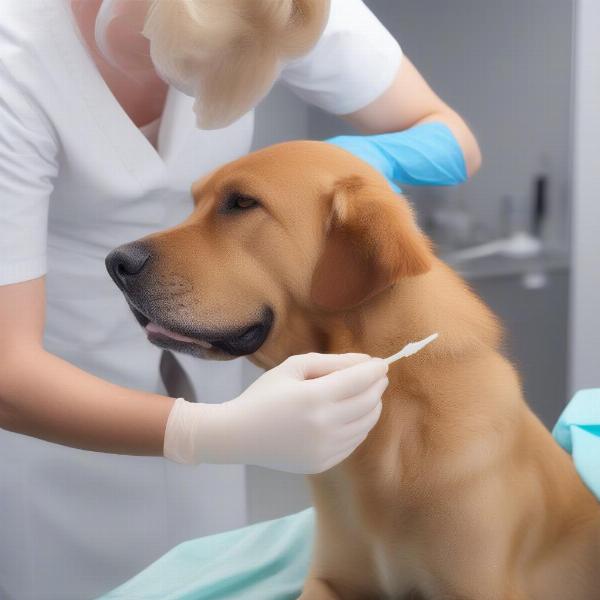Pseudomonas in dogs ears is a common and often frustrating bacterial infection. This guide provides in-depth information about recognizing, treating, and preventing pseudomonas otitis, helping you ensure your furry friend’s ear health. Understanding the causes, symptoms, and treatment options is crucial for effectively managing this stubborn infection and preventing recurrence.
Understanding Pseudomonas in Dogs
Pseudomonas aeruginosa is a type of bacteria notorious for its resistance to many antibiotics. When this bacteria infects a dog’s ear, it causes a condition known as pseudomonas otitis. This infection can be particularly challenging to treat due to the bacteria’s resilient nature. Various factors can predispose a dog to pseudomonas otitis, including allergies, ear canal abnormalities, excessive moisture, and weakened immune systems.
Recognizing the Symptoms
Identifying pseudomonas ear infection in dogs is the first step towards effective treatment. Common symptoms include:
- Head shaking: Your dog might shake their head frequently and vigorously.
- Ear scratching: Persistent scratching at the ears, often accompanied by whining or yelping.
- Ear discharge: A thick, yellowish-green or brownish discharge with a foul odor is characteristic of pseudomonas.
- Redness and swelling: The ear canal may appear red, inflamed, and swollen.
- Pain: The ear will likely be painful to the touch.
- Hearing loss: In severe cases, the infection can lead to temporary or permanent hearing loss.
Diagnosis and Treatment of Pseudomonas Ear Infections
If you suspect your dog has a pseudomonas ear infection, a visit to the veterinarian is crucial. The vet will perform a thorough examination, including an otoscopic examination to visualize the ear canal and collect samples for ear cytology. This diagnostic procedure helps confirm the presence of Pseudomonas and rule out other potential causes.
Treatment typically involves a multi-pronged approach:
- Thorough ear cleaning: The vet will clean the ears professionally to remove debris and discharge.
- Topical antibiotics: Prescription ear drops containing antibiotics effective against Pseudomonas are essential.
- Oral antibiotics: In severe cases, oral antibiotics may be necessary.
- Pain management: Pain relievers can help alleviate discomfort.
- Addressing underlying issues: Treating any underlying allergies or medical conditions that contribute to the infection is vital for long-term success.
“Addressing underlying conditions, such as allergies, is critical for preventing recurrent pseudomonas infections,” advises Dr. Emily Carter, DVM.
Preventing Pseudomonas Ear Infections
Preventing pseudomonas ear infections requires diligent care and attention:
- Regular ear cleaning: Clean your dog’s ears regularly using a veterinarian-recommended ear cleaner.
- Drying ears after swimming or bathing: Moisture creates a breeding ground for bacteria.
- Managing allergies: If your dog has allergies, work with your vet to develop a management plan.
- Routine veterinary checkups: Regular checkups can help identify and address potential ear problems early.
 Veterinarian cleaning a dog's ear
Veterinarian cleaning a dog's ear
Conclusion
Pseudomonas in dogs ears can be a persistent problem, but with proper diagnosis, treatment, and preventive measures, you can help your canine companion enjoy healthy, happy ears. Don’t hesitate to consult your veterinarian if you suspect an ear infection. Early intervention is key to successful treatment and preventing complications.
FAQ
- How long does it take to treat a pseudomonas ear infection in dogs? Treatment typically takes several weeks, even months in stubborn cases.
- Can I use over-the-counter ear drops for my dog’s pseudomonas infection? No, over-the-counter ear drops are usually ineffective against Pseudomonas and may worsen the infection. Always consult your vet.
- Is pseudomonas contagious to humans? While rare, it’s possible for humans with weakened immune systems to contract Pseudomonas. Practice good hygiene after handling your dog’s ears.
- Are certain breeds more prone to pseudomonas ear infections? Dogs with floppy ears or hairy ear canals are generally more susceptible.
- What happens if a pseudomonas ear infection is left untreated? Untreated infections can lead to chronic pain, hearing loss, and even spread to other parts of the body.
- How can I tell if my dog’s ear infection is improving? Look for reduced head shaking, scratching, and discharge. Your vet will monitor progress through follow-up examinations.
- Can diet play a role in preventing ear infections? A healthy diet can support a strong immune system, which can help prevent infections.
Related Articles
ILM Dog, a leading international pet website specializing in dog care, provides expert advice on all aspects of dog ownership, from breed selection to health care and training. Whether you’re a seasoned dog owner or just starting your journey, ILM Dog offers comprehensive resources and guidance to help you ensure your canine companion’s well-being. We are experts in Dog Breeds and Selection, Health & Medical Care, and Grooming & Hygiene. Contact us at [email protected] or +44 20-3965-8624. Visit us today at ILM Dog!